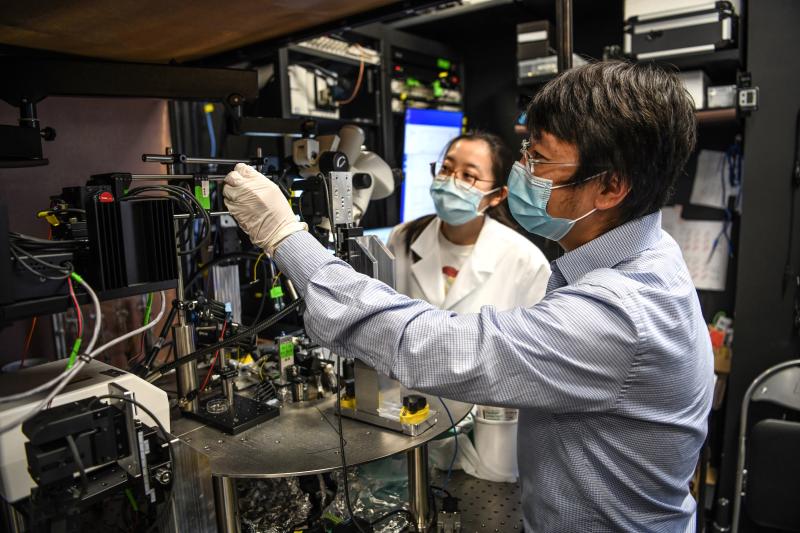
Welcome, Nuo Li, as associate professor in Neurobiology. He and many of his lab members will be joining the department beginning July 1. Li received his bachelor’s degree in Biomedical Engineering from Washington University in St. Louis, where he worked with Dr. Dora Angelaki on neural mechanisms of spatial perception. He received his PhD in Neuroscience from MIT, where he worked with Dr. James DiCarlo on neural mechanisms of visual object recognition. He then joined Dr. Karel Svoboda’s lab at Janelia Research Campus as a postdoctoral fellow where he developed tools and methods to study the circuit mechanisms of decision-making in mice.
Why did you choose to join the faculty in Duke Neurobiology?
I am very excited to join the Department of Neurobiology at Duke. In addition to its reputation for excellence in neuroscience research and education, moving to Duke Neurobiology is extremely meaningful to me and represents an inflection point for our research trajectory. This move will bring us together with an exciting group of investigators who are at the forefront of different areas in biomedical sciences. At our new home, I hope we can forge new collaborations and establish new research directions. This will surely broaden our horizon and influence our study of the brain in exciting and unpredictable ways. In turn, I hope that our research will provide unique contributions to the Department’s mission to tackle the most challenging questions in biomedical research and human health.
Where were you prior to coming to Duke?
I am coming from the Department of Neuroscience at Baylor College of Medicine, where my lab has been for the last 8 years. The research in my lab aims to understand the neural basis of voluntary movement. We employ an integrative approach, including large-scale electrophysiology, 2-photon imaging, and circuit manipulations, to elucidate the organization and dynamics of brain-wide circuits in the intact brain that produce voluntary movement.
What is your approach to mentorship?
I want my students to benefit from a training that: 1) familiarizes them with fundamental concepts of neuroscience that provides a foundation for further independent thinking; 2) trains them to apply rigorous scientific methods and evaluate evidence critically; 3) provides them a quantitative skill set, and 4) trains them to communicate effectively. I work closely with trainees in my group to realize these objectives. I hold regular one-on-one meetings with my students to give feedback on their progress, guidance on data analysis, plan future experiments, and feedback on fellowship applications and manuscript preparations. I try to make myself available both in the office and in the lab. Another important component of the training is collaboration. We had several successful projects in which the trainees were co-mentored by me and our collaborators. This not only provides a more robust support system, but it also broadens the students networking opportunities and gives them different perspectives from different mentors. I therefore embrace this kind of opportunity. While my primary goal is to help trainees advance along the traditional academic career path, as this was the only way I was trained, my broader mission is to help trainees to attain their goals (whatever they may be).
What are your research interests?
The research goal of my lab is to understand how neural circuits in the brain give rise to volitional movements. Our body is constantly in motion. For example, it is estimated that we move our eyes 2-5 times a second. Each movement is made with incredible accuracy, bringing into focus bits of the world that span only a few degrees of visual angle. This allows us to perceive and interact with the world. Volitional movements are not hardwired in the brain: when presented with the same visual scene, our eye movements take very different flight paths depending on what we are looking for. A planning phase precedes all volitional movements in which the brain programs appropriate movement on the fly to achieve the goal at hand. This fundamental process dictates our behavior, ranging from speech to motor skills. We currently lack a basic understanding of how volitional movements are planned and initiated. The way we move has deep social psychological consequences that affect our well-being. A circuit and synaptic based understanding of volitional movements will provide a roadmap for treating movement disorders.
More broadly, I have a deep interest in the intriguing link between movement and cognition. Maladaptive motor behavior and cognitive disorders are often interrelated. Many of the same brain regions that control movements are also active when we reason and think. Conversely, physical exercise attenuates cognitive impairment and reduces the risk of dementia. I propose that understanding basic mechanisms of volitional movement will provide a paradigm for a broader understanding of how multiple brain regions interact to perform fundamental computations that support cognition.
Is there anything else you would like to share about yourself?
Much of our pursuit is driven by an initial curiosity. My fascination with neuroscience began in an undergraduate neural engineering course. The idea of harnessing neural signals in the brain to control Neuroprostheses that can better the lives of patients deeply inspired me. Yet, the crudeness of the available methods at the time piqued my curiosity in the neural hardware that gave rise to these signals. I quickly abandoned my plans as a premed student and plunged myself into the basic research of systems neuroscience. I hope our work at Duke can bring me back full circle to my initial motivation and our work could one day lead to new treatments that make a tangible difference in human health.